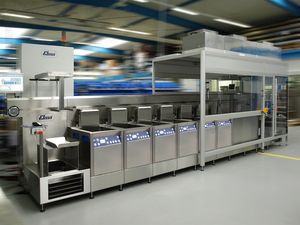Specifying Tips for Industrial Ultrasonic Cleaners
First of all, for the purpose of this post let’s define an industrial ultrasonic cleaner. Most simply they are floor mounted or wheel mounted when compared with tabletop ultrasonic cleaners. Basic ultrasonic cleaning technology is the same. The size of the parts being cleaned is high on the list of specification criteria, but also important are the steps employed to achieve the desired level of cleanliness. An example of where an industrial unit might be called for is our post on cleaning vehicle transmissions.
Cleaning Tank Size
Ultrasonic cleaning tank size is governed by the part or parts being cleaned. This also determines the amount of ultrasonic cleaning solution required to fill the tank – allowing for displacement due to parts being cleaned.
Tank size must take into account working depth to assure that parts being cleaned are totally immersed without contacting the bottom of the tank.
When calculating tank size you must also allow for the dimensions of the basket used to hold parts being cleaned and keep them from contacting the side walls and bottom of the cleaning tank. Basket dimensions are slightly smaller than the tank internal dimensions.
Large parts can be suspended in the solution without the use of a basket but care must be taken to avoid part contact with the tank. Some tank designs have a built-in rack to support the parts without contacting the bottom.
Pre-and Post-Cleaning
Pre- and post-cleaning serve two purposes in an industrial ultrasonic cleaning system. Pre-cleaning is used to remove loose or gross contaminants if present in order to prolong cleaning solution effectiveness. Post cleaning can be accomplished by a shower rinse and/or by one or more rinsing tanks either with or without ultrasound to remove all traces of cleaning solution chemistry.
The extent of rinsing is governed by the degree of cleanliness specified. Distilled or deionized water may be called for in these steps if spotting cannot be tolerated. Check our post on rinsing systems for more detail.
Cleaning by Oscillation
Oscillation can apply to cleaning and rinsing. It provides a vertical ±2 cm movement of cleaning and rinsing baskets. Cleaning is further improved by the equipment’s sweep mode to evenly distribute ultrasonic energy throughout the cleaning solution and rinsing water.
Dryers
When thoroughly dried parts are required a drying system should be employed rather than relying on evaporation. Large parts with complex shapes that can hold water call for electrically heated industrial cabinet dryers using re-circulated hot air. Examples include the ULT front-loading and WLT top-loading dryers available from Tovatech.
Cleaning Solution Maintenance
Large industrial sonic cleaning systems may hold 100 gallons or more of cleaning solution. Regardless of cleaning solution capacity it makes good sense to maintain these solutions in order to preserve their cleaning efficiency and reduce replacement cost. There is another benefit as well. Hard particles that settle to the bottom of the tank during cleaning can abrade the stainless steel and shorten tank life.
To help you maintain your solutions and equipment Tovatech provides filter pumps that separate dirt particles. An example is the dual filter system that removes pump-damaging hard particles in the first stage then smaller contaminants in the second. Treated solution is returned to the tank. Filters are replaceable.
Contaminants that rise to the surface can be removed by cleaning and skimming devices. These provide economic and ecological advantages by saving chemicals, water, and energy, and by isolating liquid waste for proper disposal.
This post does not cover all considerations that go into specifying an industrial ultrasonic cleaning installation. The sonic cleaning specialists at Tovatech are ready to work with you in scoping out the nature of your work and recommending equipment and procedures that do the job best at the most economical price.

